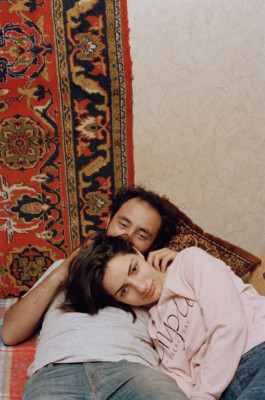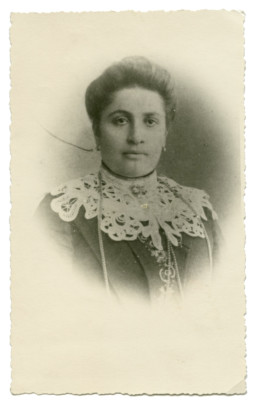

REBECCA TOPAKIAN
Dame Gulizar & Other Love Stories.
GALLERY DELPIRE & CO • PARIS, FR
2024
Exhibition text
FRENCH VERSION
BELOW ↓

© Rebecca Topakian
Originally, it was a kidnapping. “Once upon a time” is by no means a universal romance. In the highlands of Anatolia, the Caucasian tradition of marriage by abduction promises young Gulizar to her captor, Garabed. The great-granddaughter of these two protagonists, Rebecca Topakian inherits a family history that vacillates, over the generations, between reality and fiction.
Once upon a time, Gulizar and Garabed.
In the breach left by ambiguity – violence or love – and in memories abandoned hundreds of years ago, Rebecca Topakian gives birth to a series of photographs. She infiltrates the intangible life of her great-grandmother, branching out all her roots: desire, war and belief. From a possible dispossession, that of a body wrested from her consent, she gives Gulizar back her own gaze and slides it into the lives of her descendants.
Once upon another time, there was Dame Gulizar.
And so the tale begins. To recompose the forgotten story, Rebecca stages intimate relationships, finds strangers to whom she attributes her genealogy, and skilfully confuses the past with the present. Her footsteps will follow those of her ancestors; in pagan caves or Christian monasteries, on the Armenian plains of winter and summer, on lands now plundered. Where stones and bodies are mutilated: the landscape becomes skin, becomes memory. The collection of sediments, like that of archives, brings the chapters together. Between hostility and tenderness, Rebecca Topakian shares her heritage-mirage in which each photograph bears witness.
Anne Bourrassé
Translated by Delpire & Co
À l’origine ce fut un enlèvement. “Il était une fois” n’aura rien d’une romance universelle. Sur les hauts plateaux d’Anatolie, la tradition Caucase du mariage par enlèvement promet ainsi la jeune Gulizar à son ravisseur, Garabed. Arrière-petite-fille de ces deux protagonistes, Rebecca Topakian hérite d’une histoire familiale qui vacille, au fil des générations, entre réalité et fiction.
Il était une fois, Gulizar et Garabed.
Dans la brèche laissée par l’ambiguïté - violence ou amour -, et dans les souvenirs abandonnés à des centaines d’années, Rebecca Topakian fait naître une série de photographies. Elle infiltre la vie intangible de son arrière-grand-mère et lui ramifie toutes ses racines : désir, guerre et croyance. Depuis une possible dépossession, celle d’un corps arraché à son consentement, elle rend à Gulizar son propre regard et le fait glisser dans les vies de sa descendance.
Il était plusieurs fois, Dame Gulizar.
Ainsi le conte commence. Pour recomposer l’histoire oubliée, Rebecca met en scène des relations d’intimité, trouve des inconnus à qui elle attribue sa généalogie, et confond habilement le passé au présent. Ses pas iront de pair avec ceux de ses ancêtres; dans les grottes païennes ou les monastères chrétiens, sur les plaines arméniennes d’hiver et d’été, sur des terres aujourd’hui pillées. Là où pierres comme corps seront mutilés : le paysage devient peau, devient mémoire. La collecte des sédiments, comme celle des archives, rassemble alors les chapitres. Entre hostilité et tendresse, Rebecca Topakian nous confie son héritage-mirage dans lequel chaque photographie fait témoin.
Anne Bourrassé

© Rebecca Topakian
REBECCA TOPAKIAN
Dame Gulizar & Other Love Stories.
GALLERY DELPIRE & CO • PARIS, FR
2024
Exhibition text

© Rebecca Topakian
FRENCH VERSION
BELOW ↓
Three is the ternary rhythm of dissonance, disorder, acceleration.
To these words artists don’t answer.
Nothing jars, no outward violence.
It took a quartet then, of time round and long.
The number four is bound by balance, imposes suppleness and seasons.
For don’t we say three, four before the choir’s first beat?
A fourth performer is the exhibition’s natural guest,
she is the works’ roots and the substance enlacing them.
Clément, Julia, Victoire and Atmosphere.
Four beings who hang measure on time.
In the foreground, therefore,
the living in all their materials.
In mute transaction with the landscapes
without judgement Clément Borderie records
the discreet absorption of the years
that spit their ages on window blinds
or leave their marks on docile matrices.
He’ll wait for the time it takes,
the time that exceeds and evades us
the time that undoes all our certainties.
Light sometimes invites itself
through windows identical in proportion
to Julia Rometti’s canvases.
Behind the still flat tint of sand and bone, edges fade in reflections.
In front, seashells rise to the surface of several millennia
when Paris was ocean and the ocean alone on Earth.
Piece by piece, stone by stone,
the works hailed to the anonymity of ancestors: flesh land sea.
To protect the foundations,
wishes are melted into thistles.
Victoire Inchauspé’s sculptures are smitten
with fragile existences and strong molts
like a petrified mimosa awaiting spring,
like a stunned stag antlerless in winter,
like all life fulfilled in a handful of dust.
Atmosphere strikes the first note. A minim on grey concrete.
Incandescent light and false-friend silence
motors, footsteps, bursts of voices,
humming fragments of Paris’s lament.
Atmosphere suspends the shadows that make
works, bodies and feelings
exist by detachment.
The shared melody is in tune.
Three, four.
Anne Bourrassé
Translated by Sean Mark
Trois c’est le rythme ternaire du dissonant, du désordre, de l’accélération.
À ces mots, les artistes ne répondent pas.
Rien ne crispe, pas de violence en apparence.
Il fallut donc un quatuor du temps rond, du temps long.
Le chiffre quatre est lié par équilibre, il impose la souplesse et les saisons.
Finalement ne dit-on pas trois, quatre avant le premier battement de choeur.
Une quatrième interprète est l’invitée naturelle de l’exposition,
elle est les racines des oeuvres et la substance les enlaçant.
Clément, Julia, Victoire et Atmosphère.
Quatre êtres qui accrochent la mesure sur le temps.
Ainsi au premier plan,
les vivant·es dans toutes leurs matières.
En transaction muette avec les paysages
Clément Borderie constate sans juger
l’absorption discrète des années
qui crachent leurs âges sur les stores de vitrines
ou déposent leurs empreintes sur des matrices dociles.
Il attendra le temps qu’il faut,
celui qui nous dépasse et nous fait défaut
celui qui nous défait de toutes nos certitudes.
La lumière parfois s’invite
par les vitres identiques en proportions
aux toiles de Julia Rometti.
Derrière l’aplat immobile de sable et d’os, les arêtes fuient en reflets.
Devant, les coquillages remontent à la surface de plusieurs millénaires
quand Paris était océan et l’océan seul sur Terre.
Pièce par pièce, pierre par pierre,
les oeuvres sont louées à l’anonymat des ancêtres : chairs terres mers.
Pour protéger les fondations,
des voeux sont fondus dans les chardons.
Les sculptures de Victoire Inchauspé sont mordues
de fragiles existences et de fortes mues
comme un mimosa pétrifié en attente du printemps,
comme un cerf sidéré sans ses bois à l’hiver,
comme toute vie qui s’exécute dans une poignée de poussière.
Atmosphère décroche sa première note. Une blanche sur béton gris.
Une lumière incandescente et un silence en faux-ami
moteurs, pas, éclats de voix,
qui fredonnent par fragments la complainte de Paris.
Atmosphère suspend les ombres qui font exister par décrochement,
les oeuvres, les corps et les sentiments.
La mélodie commune est au diapason.
Trois, quatre.
Anne Bourrassé